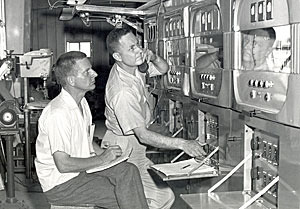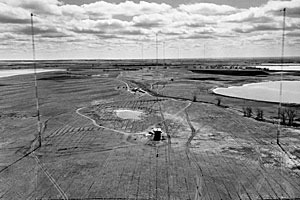50 years of WWVB
On 5 July 1963, a modest radio station in Colorado officially went on the airwaves, beginning a career of vital service to industry and the public.
Operated by the National Institute of Standards and Technology (NIST), WWVB is best known today for broadcasting the time to an estimated 50 million radio-controlled clock radios, wall clocks, wristwatches and other timekeeping devices across the US mainland. But back in 1963, the station had an entirely different audience, broadcasting standard frequencies at the high accuracy needed by satellite and missile programs. The time signal, added two years later, then became a popular means of synchronising power plants to prevent brownouts and coordinating analog telephone networks.
“WWVB was one of the original time providers that made an impact on industry,” says John Lowe, leader of NIST’s Time and Frequency Services Group. “The signal’s low frequency helped with stability and propagated very well at night.”
WWVB’s time signals are accurate because they are synchronised to NIST’s atomic clock ensemble just 80 kilometres down the road in Boulder, Colorado. This ensemble is calibrated by the NIST-F1 caesium fountain atomic clock, the US civilian time standard.

WWVB was not NIST’s first foray into radio. This year marks the 90th anniversary of NIST’s high-frequency radio station WWV, which shares the Fort Collins site. WWV began experimental broadcasts in Washington, DC, in 1920 and continuous operations in 1923, and moved to Fort Collins in 1966.
WWV provides high-frequency time and frequency signals, geophysical alerts and marine storm warnings to users, including amateur radio operators, stopwatch and timer calibration laboratories, piano tuners and telephone callers wishing to manually set watches and clocks (see www.nist.gov/pml/div688/grp40/wwv.cfm).
Power boosted
But WWVB is unique. Its legacy of innovation began with its unusually low operating frequency of 60 kilohertz. The wavelength is five kilometres long. This concept dates back to 1956, when the then-new NIST Boulder campus began operating 60 kHz radio station KK2XEI a few hours per day. The station radiated less than two watts of power but proved that low frequencies are extremely stable, with the ground below and ionosphere above forming a huge duct to guide signals around the curvature of the Earth. In 1963, WWVB’s received signal was 100 times more stable than WWV’s. (NIST experimented with even lower frequencies with standard radio broadcast station WWVL from 1960 to 1972.)

WWVB got its call sign in 1960; the B probably stands for Boulder. The station was built in Fort Collins because it is near Boulder but further from the mountains, making it easier to broadcast an omnidirectional signal. The site is also attractive for its high ground conductivity, due to highly alkaline soil.
WWVB began official broadcasts at 4 kW. The power level was later increased to 13 kW, where it remained for many years. Then in the 1980s, precision timing signals from satellites began providing an alternative for many industries’ timekeeping needs. In 1999, WWVB’s signal was boosted to 50 kW so it could reach the entire US mainland and be picked up by small antennas. This led to mass production and wide use of radio-controlled timepieces, giving consumers broad access to atomically precise NIST time.
Still innovating
Now with a power level of 70 kW, WWVB’s latest innovation is a modified time code format, which Lowe says boosts reception capability 100-fold and will encourage the inclusion of radio-controlled timing in a broader range of products. For example, appliances such as refrigerators, microwave ovens and thermostats, motor vehicles, as well as traffic light timers and lawn sprinkler systems, could now receive atomic time over the airwaves.
“This will get us beyond the novelty of clocks and watches and get the time signal to original equipment manufacturers, and get it into cars, refrigerators and sprinkler systems,” Lowe says. “My hope is that WWVB will become the source for time in a wide range of products and have a new role to play in our society.
“We look forward to another 50 years.”
2025–26 Thought Leaders: Tim Karamitos
Tim Karamitos from Ericsson discusses the connectivity requirements of emergency services and...
2025–26 Thought Leaders: Ruth Tovo
Comms Connect panellist Ruth Tovo, from the South Australian SES, discusses the technical...
ARCIA update: celebrating excellence in our industry
The ARCIA Annual Gala Dinner and Excellence Awards took place during the same week as Comms...



